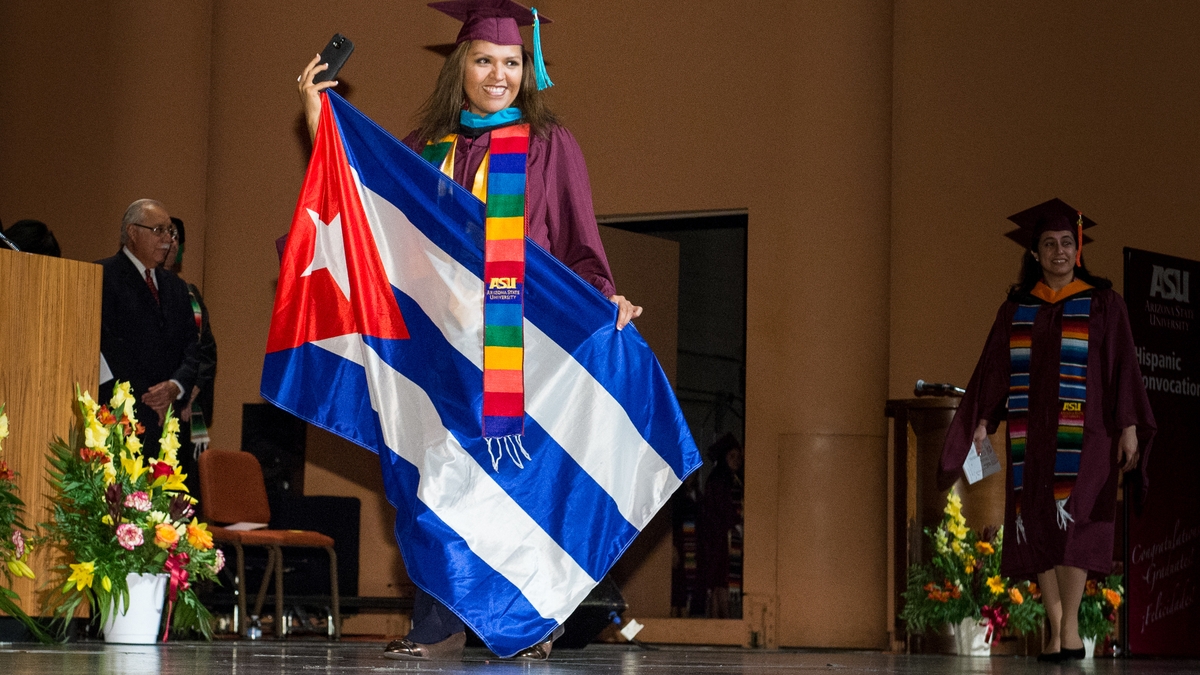Convocation celebrates graduates, reinforces Hispanic education


Arizona State University will conclude its week of graduation ceremonies on Saturday with record-breaking success and festivities that mark more than 30 years of growth in the number of Hispanic graduates.
More than 1,990 Hispanic students graduated from ASU this spring, and a record number are scheduled to participate in the 2015 Hispanic Convocation slated for 10:30 a.m. May 16 in the Wells Fargo Arena in Tempe. It is a celebration that began three decades ago in a small town square five miles from campus but now requires the capacity of one of the university’s largest venues.
The event caps off this year’s series of graduation ceremonies and underscores ASU’s success in providing a quality education to qualified students from all racial and socioeconomic backgrounds.
“This year we have nearly 400 students signed up to attend the convocation, which is the highest number we’ve ever had,” said Charlene Vasquez, ASU director of cultural relations who oversees Hispanic Convocation. “People enjoy this convocation because it provides graduates the opportunity to celebrate their academic achievement in a festive, cultural and more personal environment along with family and friends.”
Salt River Project’s Kathleen Mascareñas will emcee the event along with actor and local TV personality J.R. Cardenas, host of the Cox7 “Su Vida” – a television and online program that presents success stories about people and organizations and their impact on the Phoenix community.
Event planners expect a large crowd of families, with a guest list that runs longer than nearly all other commencement-related events.
“We know that the average ratio of graduate to guests at other events is one to eight, but for Hispanic graduates it is one to fourteen,” said Rhonda Carrillo, assistant director in ASU’s Office of Community Relations. “So that gives you an idea of the crowd size we could get.”
The Hispanic Convocation is a tradition established by ASU in 1984, when 49 students participated at an off-campus ceremony in the town of Guadalupe.
There is more to the Hispanic Convocation than festivities. Over the past decade, ASU has developed programs to encourage postsecondary success and boost access for Hispanic students in Arizona and nationally, Vasquez said.
“The annual increase in graduates participating in the ASU Hispanic Convocation is a testament to those efforts,” she said. “We’re making progress, and we’ll continue to push forward.”
Since 2005 the number of Hispanic graduates at ASU more than doubled, from 630 a decade ago to 1,990 in this year’s class.
Those numbers boosted the percentage of Hispanic undergraduates from 11 percent in the class of 2005 to 19.1 percent among this spring’s graduates, and from 6.6 percent to 9.8 percent for graduate students.
More work remains. During an April 30 presentation in Phoenix organized by the Helios Education Foundation, ASU President Michael M. Crow emphasized that Hispanics hold the highest aspiration of the American dream and that education is key to achieving the dream – financial security, strong families, happiness. Yet, only about 15 percent of Hispanics in the U.S. have graduated from college.
Crow explained that those born to families in the lowest 20 percent of family incomes – the group below the poverty line in Arizona – will most likely remain there without a college education. In Arizona, 58 percent of Hispanics live in poverty, according to the National Center for Children in Poverty.
A college education makes the difference. He highlighted data showing that, among those in the lowest one-fifth of family income who get a college degree, 84 percent move up to a higher income bracket, breaking into the middle class. And 20 percent end up in the highest income group. Crow acknowledged that education is not the only factor at play in helping people move out of poverty.
“But it’s the most important predictive variable we can affect,” he said. “You get a completely different economic outcome just from that one variable.”